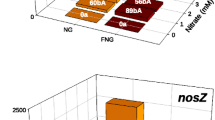Abstract
The emission of N2O from soybean plants treated with the herbicides dichlorophenoxyacetic acid (2,4-D) and bromoxynil was studied. The N2O flux from 2,4-D- and bromoxynil-treated soybean was 14.1 ng N2O-N g–1 fresh weight h–1 and 19.7 ng N2O-N g–1 fresh weight h–1, respectively, i.e. approximately twice that of the controls. The NO2 –-N concentration in 2,4-D- and in bromoxynil-treated soybean was about 8 μg N g–1 fresh weight, i.e. fivefold the concentration found in control plants. The NO3 – content in herbicide-treated soybean did not differ significantly from that of the control plants. Consequently, the accumulation of NO2 –-N during the assimilation of NO3 –-N was thought to cause the observed N2O release. Probably, N2O is a by-product produced during either the reaction of NO2 –-N with plant metabolites or NO2 –-N decomposition. Final conclusions must await further experiments.
Similar content being viewed by others
Author information
Authors and Affiliations
Additional information
Received: 5 November 1999
Rights and permissions
About this article
Cite this article
Lifeng, Z., Boeckx, P., Guanxiong, C. et al. Nitrous oxide emission from herbicide-treated soybean. Biol Fertil Soils 32, 173–176 (2000). https://doi.org/10.1007/s003740000235
Issue Date:
DOI: https://doi.org/10.1007/s003740000235




